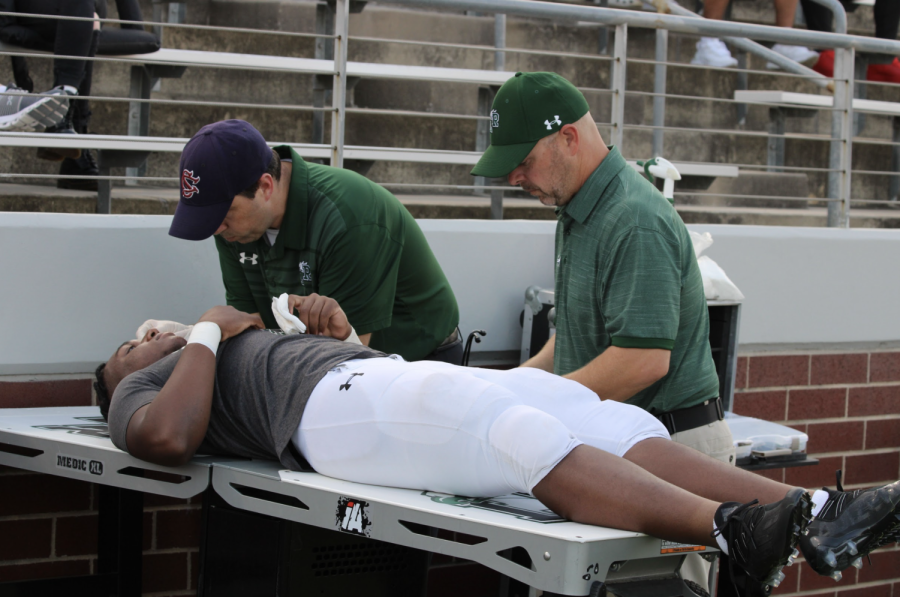The Game Plan
How Athletes Navigate Their Athletic Career After An Injury
Playing any sport can take a toll on an athlete’s body and mental state. Not only does an athlete have to face competitive obstacles and obtain unique talent, but they also have to learn how to take care of their bodies in order to perform effectively.
When injured, the responsibilities of the player may increase by adding stress and possibly dwindling the passion one has for playing the game. Junior, Kirsten Parker, has been running track since the second grade. During high school, she has dealt with two major injuries, one being a foot injury and the other a concussion.
“I was doing my takeoff and jumped too early while throwing my head back. I crashed into the poll and blacked out. My initial response when I woke up was confusion. It felt like I was a mixture of drunk and high. I had know idea what was going on and my head felt fuzzy,” said Parker.
Junior, Karsen Koehler, has been playing soccer for ten years. Her passion for the sport has always revolved around the joy of playing with her teammates and the challenging atmosphere on the field. However, when she tore her peroneal tendon, she found it hard to believe the reality of her injury.
“I was warming up before my first district game during sophomore year. I shot and landed as my ankles fell to the floor. My initial response was shock. I couldn’t believe I had just done that. But I also didn’t know how serious the injury was. I had assumed it was just an ankle sprain. Months later, we found out it was a torn peroneal tendon,” said Koehler.
The road to recovery, for some athletes, is a long one. Filled with twists and turns at every corner and at times even setbacks, it’s easy to fall into discouragement and doubt one’s capability of returning to the athlete they were prior to the injury. Junior, Jordan Greenhouse, has played basketball since he was two years old. Although preserving, Greenhouse feels as if for the entirety of his junior season he has been dealing with injuries.
“The first time I got injured I dislocated my knee. Just recently I had my first game back after getting cleared. During that game I sprained my ankle. My initial response was to laugh because I was in shock, but it was also painful. The first time I went to physical therapy, it was two months after my injury so I was already far along the healing process. I don’t know if i’ll ever be back to 100% because my knee pops. I want to try to play basketball my senior year, but after my second injury I don’t know if I will be able to,” said Greenhouse.
Attending physical therapy, icing an injury, and staying off the court, field, or track, are viable steps to healing. However, to some players, the support of their teammates and coaches was the most important element to comeback as athletes. Parker received support from a teammate the minute she awakened from her blackout and was able to walk again.
“When I first woke up I was still going in and out. I kinda remember portions of my teammates coming into the room. Once I was fully awake, I was planning on driving over to the trainers. My teammate snatched my keys and told me ‘you are not driving. Give me your keys.’ She drove me to the trainers and waited with me until my sister came to pick me up. When I arrived home my coach texted me throughout the week and called my mom to make sure I was feeling okay,” said Parker.
Junior, Cacey Below, has been playing volleyball for six years. When she faced her first serious injury she was devastating having to sit out games during the prime of her team’s season.
“My initial response to my injury was deep fear. My teammates supported me throughout my entire recovery. Even the ones who were facing their own injuries, still were there for me. My coach included me in games and practices in whatever way possible. My team talked me through every obstacle,” said Below.
Now that the year is wrapping up and seasons for each sport are coming to a conclusion, injured athletes have the opportunity to heal during the summer and return for their senior year. As long as they follow their “game plan” of attending physical therapy, leaning on their teammates and coaches, and staying encouraged, a future playing their sport is possible.


